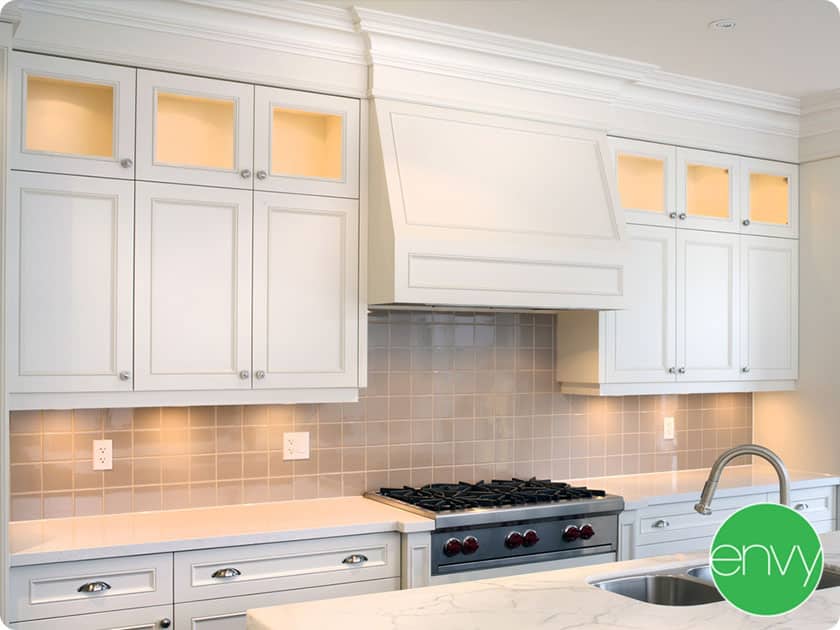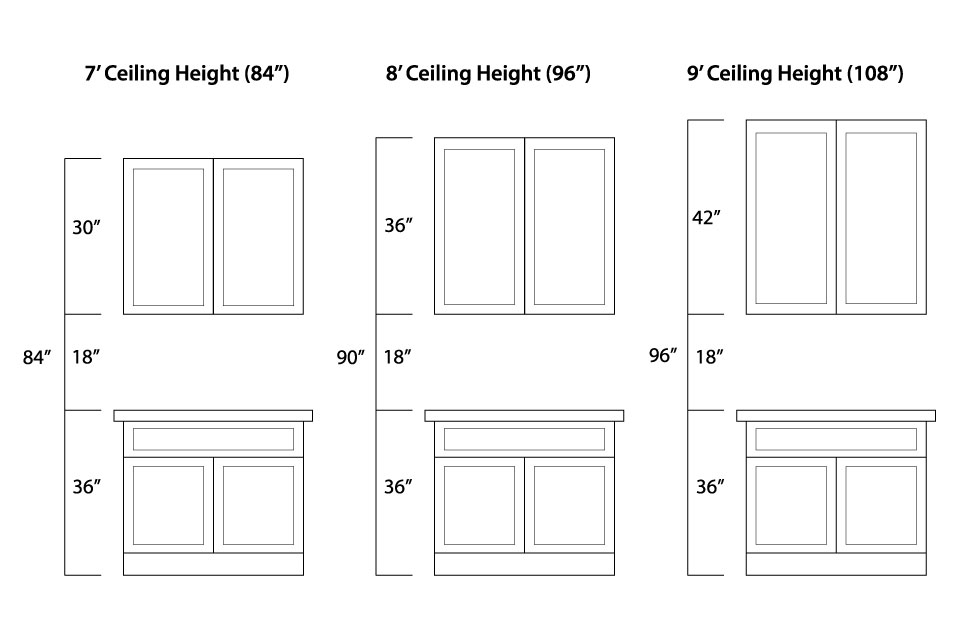Standard Distance

The standard distance between upper and lower kitchen cabinets is a crucial element in creating a functional and comfortable workspace. This seemingly simple measurement plays a significant role in determining how easily you can move around your kitchen, access your belongings, and prepare meals.
The Golden Ratio
The standard distance between upper and lower cabinets is often referred to as the “Golden Ratio” in kitchen design. This ratio, typically around 18 inches to 24 inches, is based on ergonomic principles that promote comfort and efficiency. This distance ensures enough clearance for the user to reach the upper cabinets without straining or bumping their head, while also providing ample space for comfortable movement between the counters and the upper cabinets.
Factors Influencing Cabinet Spacing

The ideal distance between upper and lower cabinets is not just about aesthetics; it significantly impacts the functionality and usability of your kitchen. Several factors contribute to determining the most suitable spacing for your kitchen.
Countertop Height
Countertop height plays a crucial role in establishing the optimal cabinet spacing. The standard countertop height is 36 inches, but this can vary based on individual preferences and ergonomic considerations. For instance, a taller person might prefer a higher countertop, while a shorter person might opt for a lower one. Adjusting the countertop height necessitates a corresponding change in the cabinet spacing to maintain a comfortable and functional work area.
Ceiling Height
The ceiling height of your kitchen directly influences the space available for upper cabinets. In kitchens with high ceilings, you have the luxury of installing taller upper cabinets, creating more storage space. Conversely, kitchens with lower ceilings might require shorter upper cabinets to prevent a cramped or overwhelming feel. The ideal distance between upper and lower cabinets is generally around 18 inches, but this can be adjusted based on the ceiling height. For example, in a kitchen with an 8-foot ceiling, a 16-inch spacing might be more suitable to avoid a cramped feeling. On the other hand, a kitchen with a 10-foot ceiling might allow for a 20-inch spacing, providing ample space for tall cabinets and a more spacious feel.
Appliance Placement
The placement of appliances, such as the refrigerator, oven, and dishwasher, can significantly influence cabinet spacing. For example, if the refrigerator is positioned near the upper cabinets, you might need to adjust the spacing to ensure adequate clearance for the refrigerator door to open without obstruction. Similarly, the placement of the oven can impact the distance between upper and lower cabinets, particularly if it is a wall-mounted oven. In such cases, you might need to increase the spacing to allow for sufficient ventilation and prevent the cabinets from overheating.
Personal Preferences, Standard distance between upper and lower kitchen cabinets
Ultimately, the ideal cabinet spacing depends on personal preferences and the specific needs of your kitchen. Some people prefer a more spacious feel and opt for a wider gap between upper and lower cabinets, while others prioritize maximizing storage space and choose a closer spacing. It’s important to consider your own cooking habits and the frequency with which you use the kitchen to determine the most suitable spacing for your needs.
Beyond the Standard: Standard Distance Between Upper And Lower Kitchen Cabinets

The standard cabinet spacing is a helpful starting point, but it’s not a one-size-fits-all solution. Kitchens come in all shapes and sizes, and individual needs can vary greatly. For instance, taller individuals might find the standard upper cabinet height too low, while a compact kitchen might benefit from more flexible cabinet configurations.
Customizing Cabinet Spacing
Customizing the distance between upper and lower cabinets offers a solution to these unique needs. This involves adjusting the height of the upper cabinets or the depth of the lower cabinets, creating a space that feels comfortable and functional.
For instance, in a kitchen with tall ceilings, you can opt for higher upper cabinets to maximize storage space without sacrificing headroom. Conversely, in a kitchen with low ceilings, you might prefer lower upper cabinets to avoid a cramped feeling. Similarly, you can adjust the depth of lower cabinets to create a more spacious feel or accommodate appliances with specific dimensions.
Alternative Cabinet Configurations
Besides adjusting the standard distance, alternative cabinet configurations can significantly impact your kitchen’s functionality and aesthetics.
Open Shelving
Open shelving is a popular choice for creating a modern and airy feel in the kitchen. It eliminates the visual barrier of closed cabinets, making the space feel larger and brighter. Open shelving can be used for displaying decorative items, showcasing cookbooks, or storing frequently used items. However, it requires careful consideration regarding clutter and dust management.
Wall-Mounted Cabinets
Wall-mounted cabinets offer a sleek and minimalist look, ideal for smaller kitchens or spaces with limited floor space. These cabinets are typically shallower than traditional lower cabinets, making them perfect for storing lighter items like dishes or glassware. They also free up floor space, creating a more spacious and open feel.
Island Layouts
Island layouts offer a flexible and functional approach to kitchen design. They provide additional counter space for food preparation, dining, or casual seating. The distance between the island and surrounding cabinets can be customized to suit the needs of the kitchen and its users.
Cabinet Spacing Options
| Spacing Option | Pros | Cons | Example |
|---|---|---|---|
| Standard Spacing (18″ – 24″) | Provides ample storage and counter space, a classic and familiar layout | May feel cramped in smaller kitchens, limited customization options | A traditional kitchen with a standard layout, featuring upper cabinets above lower cabinets at the standard distance. |
| Increased Upper Cabinet Height (24″ – 30″) | Maximizes storage space, ideal for tall individuals or kitchens with high ceilings | May require a step ladder to reach upper shelves, can feel overwhelming in smaller kitchens | A kitchen with tall ceilings, featuring higher upper cabinets to utilize the available vertical space. |
| Reduced Upper Cabinet Height (12″ – 18″) | Creates a more open and airy feel, ideal for smaller kitchens or kitchens with low ceilings | Limited storage space, may not be suitable for storing large items | A small kitchen with low ceilings, featuring lower upper cabinets to create a less cramped feeling. |
| Open Shelving | Adds visual interest, creates a more open and airy feel, easy access to items | Requires careful organization to avoid clutter, can be prone to dust accumulation | A modern kitchen with open shelving instead of upper cabinets, displaying decorative items and frequently used kitchenware. |
| Wall-Mounted Cabinets | Saves floor space, creates a minimalist and sleek look, ideal for smaller kitchens | Limited storage capacity, may not be suitable for heavy items | A compact kitchen with wall-mounted cabinets instead of lower cabinets, providing storage while maximizing floor space. |
| Island Layout | Provides additional counter space, flexible and functional, can be customized to suit specific needs | May require more space, can be more expensive than traditional layouts | A kitchen with an island in the center, offering additional counter space for food preparation and casual dining. |
Standard distance between upper and lower kitchen cabinets – When planning your kitchen layout, the standard distance between upper and lower cabinets is crucial for comfortable movement and functionality. This distance allows for ample space to reach items and prepare food. While kitchens focus on practicality, a bathroom floor cabinet with marble top can add a touch of elegance and functionality to your bathroom, creating a luxurious feel.
Similar to kitchen cabinets, the height of bathroom cabinets should be carefully considered for optimal use and accessibility.
The standard distance between upper and lower kitchen cabinets is typically around 18 inches, allowing for comfortable access and ample workspace. While this distance is perfect for kitchens, it may not be the most suitable for bathroom storage, which often requires more vertical space.
For those seeking a stylish and practical solution, the fresca torino espresso tall bathroom linen side cabinet provides a perfect balance of storage and elegance, offering ample space for towels, toiletries, and other essentials. Just as a kitchen’s layout should accommodate the standard cabinet distance, so too should a bathroom’s design consider the needs of its users and the available space.
